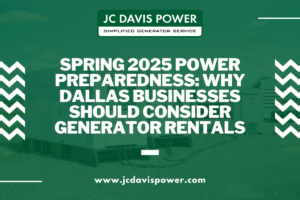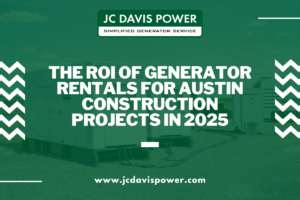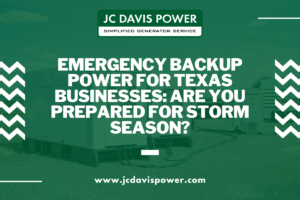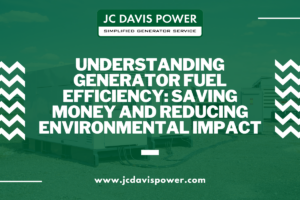Key Takeaways
- Generator rentals can reduce project capital expenditure by 40-60% compared to purchasing, freeing up resources for other critical project needs
- Flexible power solutions help construction projects adapt to changing site requirements while avoiding excess capacity costs
- Austin’s construction sector is projected to grow 8% in 2025, increasing demand for reliable, scalable temporary power solutions
- Strategic generator rental decisions can prevent costly downtime, with potential savings of $5,000-$15,000 per day on mid-sized projects
- Modern rental generators offer Tier 4 emissions compliance, reducing environmental impact and ensuring regulatory adherence
Have you ever calculated how much a single day of power outage costs your construction project? For most Austin contractors, that number ranges from thousands to tens of thousands of dollars—yet many still approach power solutions as an afterthought rather than a strategic investment. As Austin’s skyline continues to evolve and construction projects multiply across the city, having reliable, cost-effective power isn’t just convenient—it’s essential to your bottom line.
Austin’s Construction Boom: Why Power Solutions Matter Now
Austin’s construction industry isn’t just growing—it’s transforming. With a projected 8% growth in the construction sector for 2025, contractors are facing increasing pressure to maximize efficiency while minimizing costs. At the heart of this challenge lies the need for dependable power.
“The decisions you make about power solutions can impact everything from your timeline to your profit margins. It’s no longer just about having power—it’s about having the right power solution that scales with your project.”
This growing demand is reflected in market data. The U.S. generator rental market was valued at $2.58 billion in 2023 and is projected to reach $3.24 billion by 2029, growing at a CAGR of 3.85%, according to ResearchAndMarkets.com. This growth is particularly evident in construction, which accounts for the largest revenue share in the generator rental market.
Power Challenges on Modern Austin Job Sites
Austin construction sites face unique power challenges that directly impact project success:
- Grid Infrastructure Gaps: Many developing areas lack sufficient power infrastructure during early construction phases
- Weather Vulnerabilities: Texas weather extremes can disrupt grid power, particularly during summer demand peaks and winter storms
- Remote Locations: Projects on Austin’s expanding perimeter often require self-sufficient power solutions
- Variable Power Needs: Different construction phases demand different power capacities
How are fluctuating power needs affecting your project schedule? This question is becoming increasingly critical as contractors recognize that inadequate power planning can cascade into multiple problems, from idle workers to missed deadlines.
Understanding Generator Rental ROI: The Financial Logic
When evaluating generator rental ROI, you need to look beyond the simple rental fee. The true return comes from a comprehensive assessment of both direct costs and opportunity costs.
What Is Generator Rental ROI?
Generator rental ROI encompasses:
- Direct cost savings (compared to purchasing)
- Productivity gains from reliable power
- Avoided downtime expenses
- Flexibility to scale power solutions
- Reduced maintenance and compliance burdens
For most Austin construction projects, the calculation looks something like this:
| ROI Component | Calculation Method | Typical Impact |
| Capital savings | Purchase price – Total rental cost | 40-60% reduction in upfront expenses |
| Downtime prevention | Daily project cost × potential downtime days | $5,000-$15,000 saved per avoided downtime day |
| Maintenance savings | Annual maintenance costs for owned equipment | $2,500-$7,500 annually |
| Flexibility premium | Cost to right-size owned equipment for each phase | 15-30% improved efficiency through project lifecycle |
The Cost of Downtime vs. Reliable Power
Consider this: When power fails on a construction site with 25 workers earning an average of $30 per hour, you’re losing $6,000 in labor costs alone during a single 8-hour downtime day, not counting equipment rental fees, delayed material deliveries, and potential penalty clauses.
According to industry data, the continuous power application segment in construction is growing at a CAGR of 4.32%, highlighting the increasing recognition of uninterrupted power as a critical business necessity, not just a convenience.
Breaking Down Generator Rental Costs in Austin
Understanding the factors that influence temporary generator rental cost is essential for accurate budgeting and ROI calculations.
Temporary Generator Rental Cost Factors
Several variables determine what you’ll pay for generator rentals in Austin:
- Generator Capacity: Prices scale with power output (kVA/kW)
- Rental Duration: Daily, weekly, or monthly rates (with discounts for longer terms)
- Fuel Type: Diesel remains dominant but natural gas and hybrid options are emerging
- Distribution Equipment: Additional costs for distribution panels, cables, and transformers
- Service Level: Basic rental vs. full-service packages with monitoring and maintenance
In Austin specifically, generator rental prices vary based on capacity and duration. For example, a 3,500-watt generator typically rents for $55 per day or $220 per week according to local rental companies, but industrial-grade generators for major construction sites can range from $500-$3,000+ weekly depending on specifications.
Short-Term vs. Long-Term Rentals
For projects lasting 1-3 months, weekly rental rates typically offer 30-40% savings over daily rates. For longer projects, monthly rates can reduce costs by an additional 15-25%. However, accurately forecasting your project’s power needs becomes increasingly critical as rental duration extends.
Bold PAA: How do I calculate the right generator size for my construction project?
The right approach combines:
- Adding up all essential equipment wattage requirements
- Allowing 20% additional capacity for startup surges
- Planning for future expansion or additional equipment
- Consulting with power specialists who understand construction sequencing
Rental vs. Buy: The Generator Decision Matrix for 2025
The rental vs buy generator decision requires careful analysis of multiple factors, particularly for Austin projects where conditions and requirements can change rapidly.
Key Considerations in the Buy vs. Rent Debate
| Factor | Rental Advantage | Purchase Advantage |
| Initial investment | Minimal upfront cost | Long-term asset |
| Maintenance | Included or minimal | Owner responsibility |
| Flexibility | Scale up/down as needed | Fixed capacity |
| Technology | Access to latest models | Limited to purchased technology |
| Tax implications | Operating expense | Capital depreciation |
| Storage | None required | Requires secure storage |
| Emergency backup | Usually available within hours | Always available if maintained |
The diesel generator rental market currently holds the largest revenue share in the U.S., driven by high reliability and demand from large-scale industries like construction. However, it’s worth noting that the <75KVA generator segment is growing significantly (5.46% CAGR), indicating a trend toward smaller, more versatile generators that can be deployed strategically across construction sites.
Advantages of Generator Rentals for Construction Projects
For most Austin construction projects, rental advantages include:
- Matching Power to Project Phases: Different construction stages require different power capacities—rentals allow you to right-size throughout
- Preserving Capital: Free up financial resources for core business investments rather than equipment
- Eliminating Storage Concerns: No need to secure generators between projects
- Reducing Maintenance Burden: Service typically included with rental agreements
- Ensuring Emissions Compliance: Access to Tier 4 Final compliant equipment without direct investment
This strategic approach aligns with global trends, as the global generator rental market is projected to expand at a CAGR of 5.6% and be valued at $17.7 billion by 2033, according to Fact.MR.
Maximizing ROI with Strategic Rental Choices
The difference between average and exceptional generator rental ROI often comes down to strategic planning and expert implementation.
Tailoring Power Solutions to Project Needs
To optimize your power solution:
- Load Analysis: Conduct detailed power requirement analysis for each project phase
- Redundancy Planning: Determine critical systems requiring backup power
- Distribution Design: Plan efficient power distribution to minimize cable runs
- Fuel Strategy: Calculate consumption rates and develop refueling schedules
- Monitoring Solutions: Implement remote monitoring to prevent downtime
“The contractors who see the best ROI approach generator rentals as a strategic decision rather than just checking a box. They collaborate with their power provider during the planning phase, not just when they need the equipment delivered.”
Mitigating Risks: Maintenance, Support, and Compliance
Environmental regulations continue to tighten, making emissions compliance increasingly important. The latest Tier 4 emissions standards require sophisticated engine technology and after treatment systems—technology that evolves rapidly and represents significant investment if purchased.
With rentals, compliance risk transfers to the rental provider, who maintains a fleet of current, compliant equipment. This alone can represent substantial ROI for construction firms that would otherwise need to update owned equipment regularly.
Industry Benchmarks and ROI Metrics for Generator Rental
How do you know if your generator rental ROI meets industry standards? While every project is unique, several benchmarks can help gauge performance.
Industry Standard Metrics
Leading Austin contractors track these KPIs:
- Power Reliability Rate: Target >99.5% uptime for construction site power
- Cost per kWh: Typically $0.30-$0.45 for rental generators (inclusive of all costs)
- Power Cost as Percentage of Project Budget: Ideally 0.5-2% of total project costs
- Response Time for Service Issues: Industry leaders demand <4 hours for critical issues
- Fuel Efficiency: Modern rental units should deliver 25-35% better efficiency than units 5+ years old
With the construction sector accounting for the largest revenue share in the U.S. generator rental market, these metrics are becoming increasingly standardized across the industry.
Calculating & Communicating ROI
For project managers looking to justify generator rental decisions to stakeholders, this simplified ROI formula provides clarity:
ROI = (Value of Benefits – Cost of Generator Rental) / Cost of Generator Rental × 100%
Where “Value of Benefits” includes:
- Avoided downtime costs
- Labor efficiency gains
- Schedule adherence value
- Avoided purchase/maintenance costs
- Risk mitigation value
Example: A 6-month Austin construction project requiring a 100kW generator might show:
- Total rental cost: $25,000
- Avoided downtime value: $20,000
- Labor efficiency gains: $12,000
- Avoided maintenance: $5,000
- Risk mitigation value: $8,000
ROI = ($45,000 – $25,000) / $25,000 × 100% = 80%
This 80% ROI demonstrates the substantial value generator rentals can deliver when properly implemented.
Real-World Applications: Generator Rentals as a Competitive Advantage
Forward-thinking Austin contractors are leveraging strategic project power solutions to gain competitive advantages.
Strategic Use Cases
Successful applications of generator rentals in Austin include:
- Fast-Track Commercial Development: Using temporary power to begin work while waiting for permanent utility connections—potentially shaving weeks from schedules
- Multi-Phase Projects: Scaling power capabilities up or down as project phases change
- Downtown Construction: Using quieter, cleaner Tier 4 generators to meet noise and emissions requirements in dense urban environments
- Infrastructure Projects: Providing mobile power that follows active work zones
- Disaster Recovery: Quickly deploying power after extreme weather events
Industry Insights and Local Expertise
The most successful projects typically partner with local power specialists who understand Austin’s unique construction environment, permitting requirements, and seasonal challenges.
Having a power partner who understands the local grid, permitting process, and even the weather patterns makes a significant difference. They can anticipate issues before they become problems.
Local expertise from providers like J.C. Davis Power’s Austin generator service often includes guidance on:
- Meeting City of Austin noise ordinances
- Navigating permit requirements for temporary power
- Preparing for seasonal power demand fluctuations
- Planning for weather contingencies
- Coordinating with utility connections
Future-Proofing Construction Power: What’s Ahead for Austin
As we look toward 2025 and beyond, several trends are reshaping construction site power in Austin:
- Hybrid Power Systems: Combining generators with battery storage for improved efficiency
- Remote Monitoring: IoT-enabled generators that allow real-time monitoring and predictive maintenance
- Alternative Fuels: Increasing adoption of natural gas, biodiesel, and hydrogen fuel cells
- Grid Integration: Smart generators that can interact with temporary microgrids
- Sustainability Focus: Lower-emission solutions becoming standard expectations
The construction firms that adapt to these trends earliest will likely see the highest ROI from their power solutions.
Conclusion: Maximizing Your Generator Rental ROI in 2025
As Austin’s construction landscape continues to evolve, the strategic approach to temporary power will increasingly differentiate successful projects from struggling ones. Generator rentals offer a compelling combination of financial flexibility, technological access, and risk mitigation that most construction projects can leverage to improve both their bottom line and operational efficiency.
By understanding the true costs and benefits, tailoring solutions to your specific project needs, and partnering with knowledgeable local providers, you can transform your approach to construction site power from a necessary expense into a strategic advantage.
Ready to optimize your project’s power strategy? Contact J.C. Davis Power for a customized assessment of your construction power needs and discover how the right generator rental approach can boost your project’s ROI.
FAQ: Generator Rentals for Austin Construction Projects
What size generator do I need for my Austin construction project?
Generator sizing depends on your specific power requirements. Calculate the total wattage of all equipment that will run simultaneously, then add 20-30% for starting surges. For most medium-sized Austin construction sites, generators in the 60-150kW range are common, while larger projects may require 200kW+ or multiple units. A power specialist can perform a detailed load analysis to ensure you get the right size.
How much should I budget for generator rental on my construction project?
In Austin, you should typically budget 0.5-2% of your total project cost for temporary power solutions. Daily rates for construction-grade generators range from $150-$1,000+ depending on size, with significant discounts for weekly or monthly rentals. Additional costs may include distribution equipment, setup/teardown, fuel, and monitoring services.
What happens if my rented generator fails during a critical project phase?
Reputable generator rental companies in Austin offer 24/7 emergency service with replacement guarantees. Service response times typically range from 1-4 hours depending on your service agreement. For critical applications, consider redundant power solutions or generators with auto-start backup capabilities to prevent downtime entirely.
Are there environmental regulations I need to consider when renting generators in Austin?
Yes, Austin has specific emissions and noise regulations that apply to temporary power. All generators must meet EPA Tier 4 Final emissions standards for new non-road diesel engines. Additionally, noise ordinances may restrict operation in residential areas, particularly during evening hours. Your rental provider should supply compliant equipment and advise on proper placement and sound attenuation.
How far in advance should I schedule a generator rental for my construction project?
For standard construction generators, reserve at least 2-3 weeks in advance. For large capacity units (200kW+), specialized equipment, or during peak construction seasons (spring/summer), schedule 4-6 weeks ahead. During emergency situations like severe weather events, availability becomes extremely limited, so having an established relationship with a provider is valuable.





